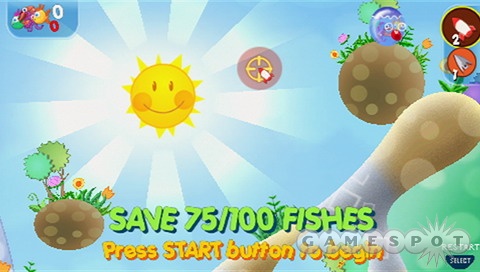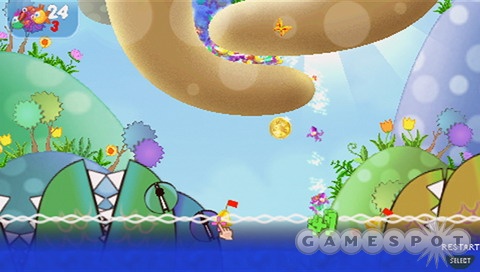What happens when you combine the cuteness of Loco Roco and the gameplay of Lemmings? You end up with Downstream Panic!, a fun puzzler with more than a passing resemblance to both games. Downstream Panic! is an absolute blast for a few hours, but erratic physics make some of the later levels extremely difficult, and there aren't many other ways to enjoy the game if or when you get stuck.

Downstream Panic's premise couldn't be simpler: Tiny fish are poured out of containers at the top of the 2D level and you must guide them through mazelike levels to the safety of the water below. This is easier said than done. For starters, you're required to save a specific number of the 100 fish with which you start off. This number varies from one level to the next, but the consequence of losing too many remains the same: If you fall below the number, you'll have to try again. Another obstacle is that only a small portion of the water at the bottom of the screen (marked by two buoys) is safe for the fish--the rest is filled with large carnivorous fish that are gnashing their teeth in anticipation of snacking on your little friends.
Avoiding the chomping jaws at the bottom is one problem, but the real challenge lies in getting the fish through the level itself. Because the fish are at the mercy of the flowing water that pours out with them, you don't have any direct control over their actions. Rather, you must use the few tools available to make sure the water goes where you want it to go. You'll start with a bomb, which can be used to blow up parts of the level. Next you'll get a seed, which will instantly grow into a plant that blocks the flow of water. Eventually you'll get a harpoon that can be used to kill enemy fish that sometimes lie in wait, coming to life when water hits them. Later levels introduce clouds, which let you perform tasks without having to worry about where your fish are going because they actually catch and hold fish, as well as rainwater. The clouds can even be blown from one part of the level to another using a fan. Keep in mind, however, that unless you're playing free mode, which is where you can buy additional tools, you'll have to make do with a limited, predetermined number of items on each level, so you'll have to plan carefully.
The first 30 or so of the game's 80 levels are well designed and ease you into the concept of saving fish. Trial and error is the name of the game, but the developer made failure as painless as possible. You can fast-forward at any time--a handy tool when you've figured out the first part of a level and want to quickly get to the next step. Even more useful is the ability to restart at any time and without penalty with the press of a button--this makes the whole experience significantly less frustrating. This gentle learning curve, combined with satisfying gameplay make the first part of the game a blast--you'll really get a kick out of solving the levels and saving the fish.
However, once you pass level 30, things get crazy. You'll need all the tools you can get your hands on because the level designs go from friendly to fiendish in the blink of an eye. Not only do the layouts become more complicated, but more hazards are introduced. There are poisonous mushrooms, spiky chestnuts, teleports, storm clouds, and pesky bridges that can only be moved by spinning flowers with water or wind. Eventually, levels combine most--if not all--of these hazards and obstacles. This is when the experience goes from challenging to frustrating--there's simply too much going on and too much left to chance.
When things get too hectic, you'll find the cursor moves too slowly and lament the levels' vertical nature, which forces you to scroll up or down frequently because so little of an area is shown on the screen. There's also no way to zoom out. The game's questionable physics mean water will sometimes flow in unexpected ways and rocks won't always move where you want them to move. Sometimes the rocks don't move at all because their path is blocked by a few miscellaneous pixels of ground that didn't get blown up when a bomb was detonated. The random behavior of objects practically ensures that you'll encounter some levels that feel like they can't be beat because you'll have done everything properly, but some quirk prevented your success.
When you do invariably find yourself stuck, you're left with limited options. There are tips available in the pause menu, but these "tips" are general advice on how to use tools--they aren't hints and aren't level-specific. There are two other play modes available, but they involve replaying levels you've already beaten, so they're of limited appeal. Multiplayer is nonexistent, and there's no way to create or share levels, which is a rather significant oversight. The manual encourages you to visit the game's official Web site for new downloadable levels, but as of this writing, there's nothing available.
Downstream Panic's presentation bears more than a passing resemblance to Loco Roco. The 2D visuals are simple and attractive, giving the game a lighthearted feel. The little fish are cute and the levels are full of all the colors of the rainbow. Even the sun and clouds have faces, as well as a bit of personality. All this cuteness belies the fact that a serious fate awaits your fish when you fail to get them to the goal. It's actually kind of depressing to see your fish get chomped to a bloody pulp or flop around on the ground if they get stuck on dry land.

The game's audio sounds as if it was scooped up off of Loco Roco's cutting-room floor. Your fish sing a happy-sounding tune that loops endlessly, and each individual fish cries out when it becomes dinner. This is all cute for a while, but it quickly becomes repetitive--especially when you've been stuck on the same level for an hour.
All in all, there's a lot to like about Downstream Panic!: The gameplay is addictive, the visuals are attractive, and it's well suited to play on the go. It's a shame that the difficulty isn't more consistent and that there aren't more play modes. But even with these issues, Downstream Panic! is a good game that should not only please Lemmings and Loco Roco fans, but anyone looking for a challenging puzzle game.